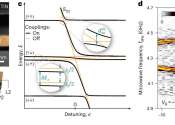Strongly anisotropic spin relaxation observed in graphene
Researchers of the ICN2 Physics and Engineering of Nanodevices Group, led by ICREA Prof. Sergio O. Valenzuela, have unambiguously demonstrated the anisotropic nature of spin relaxation in graphene when interfaced with transition ...







